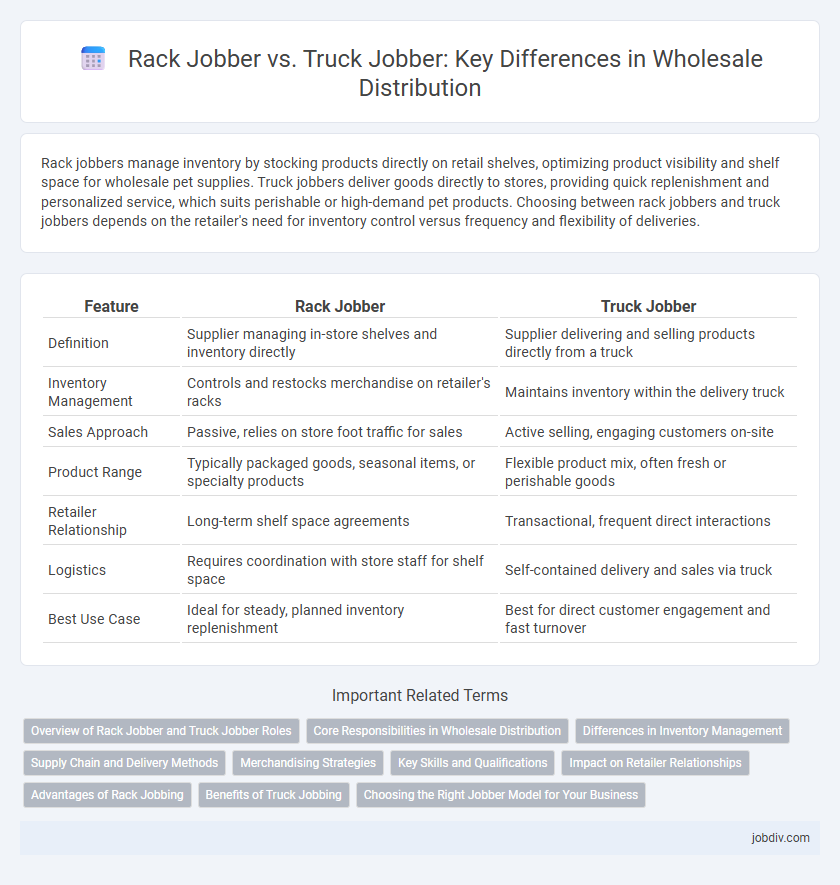Rack jobbers manage inventory by stocking products directly on retail shelves, optimizing product visibility and shelf space for wholesale pet supplies. Truck jobbers deliver goods directly to stores, providing quick replenishment and personalized service, which suits perishable or high-demand pet products. Choosing between rack jobbers and truck jobbers depends on the retailer's need for inventory control versus frequency and flexibility of deliveries.
Table of Comparison
| Feature | Rack Jobber | Truck Jobber |
|---|---|---|
| Definition | Supplier managing in-store shelves and inventory directly | Supplier delivering and selling products directly from a truck |
| Inventory Management | Controls and restocks merchandise on retailer's racks | Maintains inventory within the delivery truck |
| Sales Approach | Passive, relies on store foot traffic for sales | Active selling, engaging customers on-site |
| Product Range | Typically packaged goods, seasonal items, or specialty products | Flexible product mix, often fresh or perishable goods |
| Retailer Relationship | Long-term shelf space agreements | Transactional, frequent direct interactions |
| Logistics | Requires coordination with store staff for shelf space | Self-contained delivery and sales via truck |
| Best Use Case | Ideal for steady, planned inventory replenishment | Best for direct customer engagement and fast turnover |
Overview of Rack Jobber and Truck Jobber Roles
Rack jobbers manage inventory by stocking and merchandising products directly on retail shelves, ensuring optimal product placement and maintaining shelf space in stores. Truck jobbers deliver products directly to retail locations via trucks, handling both distribution and restocking while often providing sales support and customer service. Both roles streamline supply chain operations in wholesale, but rack jobbers focus on inventory control within stores, whereas truck jobbers emphasize delivery and replenishment logistics.
Core Responsibilities in Wholesale Distribution
Rack jobbers specialize in managing inventory and merchandising directly on retail store shelves, ensuring product assortment, stock replenishment, and display optimization within wholesale distribution. Truck jobbers focus on delivering goods, typically perishables or high-turnover products, directly to retail locations, managing transportation logistics and order fulfillment. Both roles play essential parts in maintaining efficient supply chains but differ primarily in their operational scope within wholesale distribution.
Differences in Inventory Management
Rack jobbers manage inventory by owning and maintaining product displays within retail stores, ensuring shelves are stocked and organized while retailers handle point-of-sale transactions. Truck jobbers combine inventory ownership with direct delivery and sales, carrying products in trucks and replenishing stock on-site, allowing for tight control of inventory levels and quick response to demand changes. The key difference lies in rack jobbers relying on store shelf allocation, whereas truck jobbers manage inventory through mobile sales operations.
Supply Chain and Delivery Methods
Rack jobbers manage inventory by stocking products directly on retail shelves, optimizing in-store supply chain efficiency with consistent restocking and reduced storage costs. Truck jobbers deliver goods via mobile distribution directly to retailer locations, enabling faster replenishment and flexible routing that enhances last-mile delivery performance. Both methods improve wholesale distribution but differ in their approach to inventory control and delivery speed within the supply chain network.
Merchandising Strategies
Rack Jobbers maximize merchandising efficiency by managing product placement and inventory within retail stores, leveraging fixed rack spaces to ensure consistent shelf presence and attractive displays. Truck Jobbers focus on direct store delivery, utilizing mobile merchandising to adjust inventory dynamically, respond quickly to demand fluctuations, and introduce new products in real-time. Both strategies optimize sales through tailored inventory management, with Rack Jobbers emphasizing in-store presentation and Truck Jobbers prioritizing distribution agility.
Key Skills and Qualifications
Rack jobbers excel in inventory management and merchandising skills, ensuring optimal product placement and stock levels within retail stores. Truck jobbers require strong logistics and route planning abilities, combined with customer relationship management to efficiently deliver and replenish goods on a mobile basis. Both roles demand attention to detail, negotiation skills, and familiarity with wholesale distribution practices.
Impact on Retailer Relationships
Rack jobbers enhance retailer relationships by managing inventory directly on store shelves, ensuring timely restocking and minimizing out-of-stock situations, which boosts retailer satisfaction and sales. Truck jobbers contribute to retailer trust through frequent deliveries and personalized service, providing flexibility and direct communication that can address retailers' immediate needs effectively. Both models impact retail partnerships by balancing inventory control and service frequency, influencing retailer loyalty and operational efficiency.
Advantages of Rack Jobbing
Rack jobbing offers efficient inventory management by allowing suppliers to control product placement and stock levels directly within retail stores, reducing the risk of stockouts. It enhances product visibility and merchandising expertise, leading to increased sales and better brand representation. Rack jobbers also reduce overhead costs for retailers by handling restocking and shelving, creating a streamlined supply chain.
Benefits of Truck Jobbing
Truck Jobbing provides enhanced flexibility and immediate product replenishment by delivering goods directly to retail locations, reducing storage and handling costs. This model improves inventory turnover rates and increases sales opportunities through personalized service and real-time stock adjustments. Truck Jobbers also enable swift market response and stronger retailer relationships compared to traditional Rack Jobbing.
Choosing the Right Jobber Model for Your Business
Selecting the ideal jobber model depends on inventory control and delivery frequency, where rack jobbers manage in-store shelving and replenishment, optimizing product visibility and reducing retailer workload. Truck jobbers offer direct delivery from a mobile inventory, ensuring freshness and tailored stock based on real-time customer demand. Businesses must analyze factors like product type, sales volume, and logistics capabilities to decide between rack and truck jobber models for efficient wholesale operations.
Rack Jobber vs Truck Jobber Infographic

 jobdiv.com
jobdiv.com